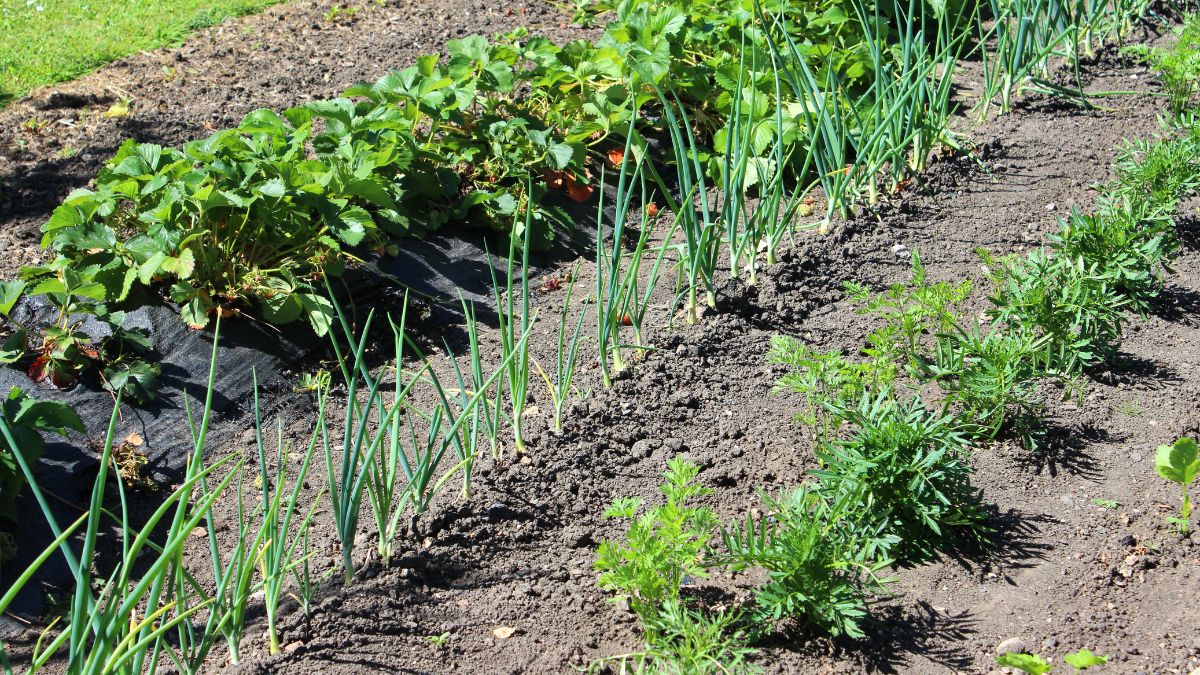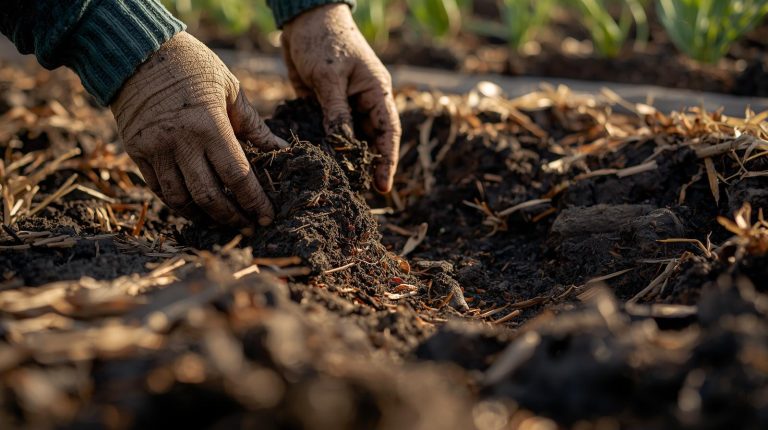Companion planting is a great way to maximize the efficiency of your garden and get the most out of your resources. By combining different plants together, you can increase yields, reduce pest problems, and improve soil quality. You can also attract beneficial insects and wildlife, improve air quality, and conserve resources.
The idea behind companion planting is that when two or more different species of plants grow together, they can help each other out. By pairing the right plants, you can get a variety of benefits.
For example, some plants will help with pest control, while others may provide shade or act as a fertilizer. With the right combination, you can maximize your yields and create an attractive and healthy garden.
Improved Yields
Companion planting can significantly boost crop yields, so it’s definitely worth giving it a try! By diversifying the types of crops you plant, you give yourself the opportunity to increase yields for the same amount of space. This is especially true if you have limited space to work with.
Not only does it help to diversify your crops, but it also helps to limit the number of weeds you have to contend with. When you companion plant, the crops you choose will attract beneficial insects that feed on the pests that would otherwise plague your garden. This reduces the amount of time and money you would otherwise spend to control these pests.
In addition, companion planting can help you get the most out of your soil. By growing plants with different root systems and nutrient needs, you can ensure that the soil is constantly replenished and full of the nutrients your plants need to thrive. This not only helps your crops to produce more, but also reduces the need for chemical fertilizers and pesticides, which can be damaging to the environment.
Companion planting is a great way to maximize your garden’s potential. It allows you to make the most of the space you have while providing a healthy environment for your crops to grow. With the right selection of companion plants, you can ensure that your garden is productive and yields are maximized.
As you move into the next topic of ‘reduced pest problems’, it’s important to remember that companion planting can be a key part of keeping your garden healthy and free of pests.
Reduced Pest Problems
Growers have experienced reduced pest problems when strategically pairing plants together, creating an almost magical effect. Companion gardening is a great way to naturally control pests using plants that have a beneficial relationship with one another.
This method of gardening is often referred to as intercropping and is known to outcompete pests with the help of natural pest control. For example, companion plants such as garlic and onions are known to repel certain insects. Other plants, such as marigolds, are known to repel nematodes that can damage underground crops such as potatoes.
Planting certain herbs near vegetables can also reduce the presence of certain pests. The great thing about companion gardening is that it doesn’t require any additional chemicals or pesticides. This can help to keep the environment healthy, since synthetic pesticides can be harmful to the soil, water, and air.
Additionally, companion gardening can help to create a diverse and balanced eco-system in the garden as the plants will naturally protect each other from pests. The benefits of companion gardening don’t stop at reduced pest problems. The improved soil quality that comes with this method of gardening also helps to promote a healthy and productive garden.
Improved Soil Quality
You may have heard of companion planting, but did you know that it can also improve the quality of your soil?
Companion planting can increase the nutrient availability and fertility of the soil, allowing you to grow bigger and healthier crops. Not only does this result in higher yield, but it also means you don’t have to spend as much on fertilizers.
So, get ready to learn all about how companion planting can enhance your soil and make gardening easier!
Related Article: Herbal Gardening Tips for Green Thumbs and Curious Mind
Enhanced Nutrient Availability
By planting certain vegetables next to one another, you can increase the nutrient availability of your garden, so you can get more out of the same amount of space!
Companion planting helps to enhance soil fertility by adding organic matter to the soil as plants decompose. It also improves soil aeration, which allows more oxygen to reach the roots of plants. Additionally, companion planting provides natural pest control, as some plants repel pests from other plants in the garden.
These benefits of companion planting can help to make sure that your garden is getting the most out of the nutrients available, allowing for a healthier, more productive and bountiful garden. By taking the time to plan out your companion planting, you can reap the rewards of improved nutrient availability in your gardening efforts.
Improved Soil Fertility
Adding organic matter to the soil helps to boost fertility and create an environment conducive to healthy plant growth. Companion planting is an effective way to increase the fertility of the soil as it increases the biodiversity of the soil by introducing different species of plants. This provides the soil with a range of different nutrients and minerals that it may have been lacking.
Additionally, companion planting often uses more efficient harvesting techniques, such as intercropping, which further aids in soil fertility. As a result, the soil is able to better support the growth of the plants, leading to a larger and healthier harvest. These benefits of companion planting help to conserve resources and are essential for sustainable agricultural practices.

Conserved Resources
By planting different types of plants together, you can conserve resources like water and soil nutrients. Companion planting offers a number of benefits, including increased biodiversity and reduced water usage.
Companion planting encourages biodiversity by allowing plants of different varieties to thrive in close proximity. This helps to ensure that the soil remains healthy and prevents weeds from dominating the garden. Additionally, by providing a diverse range of habitats, it attracts beneficial insects and wildlife which help to pollinate the plants and consume pests.
When two or more plants are planted close together, they can help to reduce water loss from the soil. For example, when shallow-rooted plants are planted alongside deep-rooted plants, the deep-rooted plants can help to draw water from deeper in the soil, which can then be used by the shallow-rooted plants. This can help to conserve resources, as water is not lost to evaporation.
In addition to conserving resources, companion planting also helps to attract beneficial insects and wildlife, allowing for a healthier and more productive garden.
Attracting Beneficial Insects and Wildlife
Incorporating companion planting into your garden will bring a wealth of beneficial insects and wildlife to your outdoor space, creating a vibrant ecosystem that will leave you in awe.
Companion planting can be used as a natural form of pest control, as certain plants can attract beneficial insects and other organisms that prey on pests. In addition, companion planting can help promote beneficial fungi, which can help plants fight off disease and build up their natural defenses.
The presence of beneficial insects and wildlife, along with the beneficial fungi, can help protect your plants from pests and diseases. This can lead to better plant health, as the plants no longer have to expend energy fighting off pests and diseases. As a result, the plants can focus on growth and producing more food.
Moreover, the presence of beneficial insects and wildlife can create a more harmonious and balanced ecosystem in your garden.
As you can see, companion planting can be a great way to attract beneficial insects and wildlife to your garden. This can provide natural pest control, as well as improved plant health. To get the most out of companion planting, it’s important to do your research and understand which plants work best together. This way, you can create the perfect environment for a thriving and vibrant garden.
With this in mind, it’s time to move on to the next topic: improved plant health.
Improved Plant Health
By leveraging the benefits of companion planting, gardeners can significantly improve the health of their plants. Through this method, they can provide natural pest control, which helps to keep insects and pests at bay without the need for harsh chemical treatments. Additionally, crop rotation can be used to prevent pests from becoming resistant to certain treatments.
Furthermore, companion planting can help to promote a healthy soil environment, which can lead to better water retention and improved nutrient uptake. Here are some of the benefits of companion planting that can help to improve plant health:
- Improved water retention in the soil
- Reduced susceptibility to pests and diseases
- Increased nutrient uptake from the soil
- Increased oxygen levels in the soil
- Decreased need for chemical treatments
By utilizing companion planting, gardeners can help to keep their plants healthy and thriving in an organic and sustainable manner. It can also help to reduce the amount of time and effort spent on managing pest problems, and provide better-quality air in and around the garden.
Moving on to the next section, improved air quality can be achieved through companion planting as well.
Improved Air Quality
You can breathe easier knowing that companion planting can help improve the air quality around your garden. By attracting beneficial insects that act as natural pest control, companion planting helps to reduce the need for chemical pesticides. This, in turn, creates a healthier, cleaner environment by limiting the use of potentially hazardous substances.
Furthermore, companion planting can help to regulate the climate in the garden by providing shade and wind protection. This results in a more pleasant atmosphere for garden visitors to enjoy.
Additionally, companion planting can provide a natural air filter by taking in pollutants from the atmosphere. This helps to reduce air pollution and improve the quality of the air in the area. Moreover, companion planting can help to increase the oxygen content of the air, allowing for more efficient respiration and better overall health.
Overall, companion planting is a simple yet effective way to improve the air quality of your garden. By providing natural pest control, climate regulation, and air filtration, companion planting helps to create a healthier and more pleasant atmosphere for you and your plants.
Related Article: How to Grow Vegetables in Aquaponics System
Frequently Asked Questions
What are the best plants to use for companion planting?
You can leverage the benefits of companion planting with techniques like planting marigolds near tomatoes. By doing so, you’ll create a beautiful garden full of diverse plants and natural pest control. Through companion planting, you can reap the rewards of a healthier, more productive garden.
What are the risks associated with companion planting?
Companion planting carries risks, such as disease transmission and weed control. If not done properly, it can damage the crops and harm your yield. Be sure to research thoroughly and practice caution to ensure successful companion planting.
How much space should be allotted for companion planting?
Jump right in and get your hands dirty – it’s time to figure out how much space you should allot for companion planting! Timing is key, so consider the companion planting benefits to decide if you need more or less space. By being mindful of the plants you are pairing, you can maximize the benefits of companion planting.
How often should companion planting be done?
Companion planting should be done every planting season. Consider companion spacing and plant selection to maximize the benefits of your garden.
Are there any potential environmental impacts of companion planting?
You must be joking! Companion planting is a great way to increase plant diversity and boost soil fertility, without any environmental impact whatsoever. So go ahead, plant away – you’ll be glad you did!
Conclusion
You’ve learned all about the benefits of companion planting. It’s clear that companion planting is a great way to improve your garden. From improved yields, to reduced pest problems, you get all these benefits.
You also conserve resources and attract beneficial insects and wildlife. Plus, you can improve the air quality of your garden by using companion planting. On top of all this, you can expect to see a 30% increase in yields when using companion planting methods!
Now that you know the benefits of companion planting, you can start reaping the rewards of a more productive and healthier garden.





